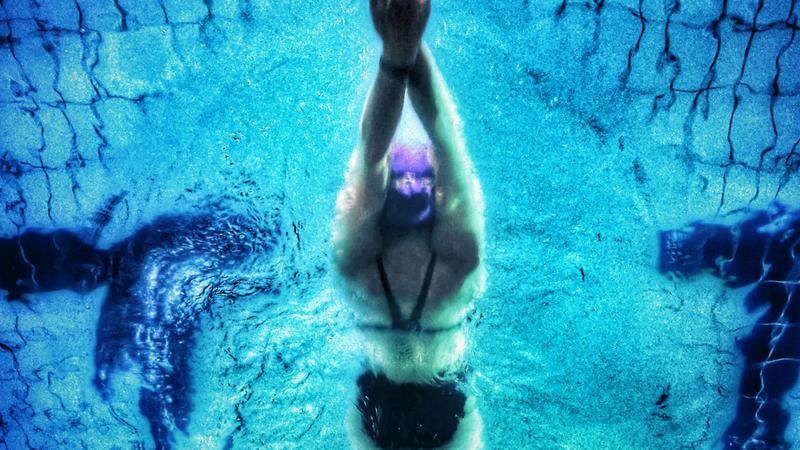by Devyn Andrews
June 4, 2024
Kiss the Undertow by Marie-Hélène Larochelle; Michelle Winter (Translator); House of Anansi Press; 184 pages; $18.00.
Swimming, unlike hiking or skiing (or even golf), offers few opportunities for scenic enjoyment, and as anyone who regularly swims laps can attest, looking at bottom of the pool is boring. But there’s something about the repetitive, rhythmic nature of freestyle—the measured strokes, the regularly-paced breathing—that provides a kind of dissociative experience, much like the road amnesia one encounters while driving for miles along a familiar highway. The dark line marking the center of the lane below becomes almost hypnotic—the muffled silence of the water and the myopic, unchanging world of the pool allow one’s mind to wander.
Marie-Helene Larochelle’s Kiss the Undertow (translated from French by Michelle Winters) posits an extreme kind of opposite, one where the dissociative effects of swimming are anything but meditative. Throughout the novel, which follows an elite swimmer along her rigorous training regimen, water itself is rendered as an adversarial force, the story’s numerous pools, rivers, and oceans becoming sites of immersive physical and psychological horror.
Set first in Toronto and later in coastal France, the unnamed first-person narrator struggles to meet the demands of her strenuous practice schedule in preparation for a national swimming competition. Every aspect of her life is built around shaving milliseconds off her race times. While desperately striving to meet athletic expectations, the narrator suffers from self-harm and disordered eating, often turning towards drugs and alcohol. She also faces disturbing physical, sexual, and psychological abuse, perpetrated at various times by her coach, the team doctor, and even her male teammates. As the violence escalates and the narrator experiences additional loss, she falls into further isolation, becoming progressively more detached. The narration begins to slip between reality and hallucination, and boundaries between the narrator’s external and internal worlds seem to become porous.
The consistent blurring of physical and psychological environments is one of the biggest strengths of Kiss the Undertow. From its opening paragraphs, we are immersed in a world where the water is a medium of distortion. Diving into the pool, the narrator says, “My goggles are fogged, distorting my view, though there’s nothing to see. I orient myself instinctively.... My arms and legs pound the water in violent rhythm. I liquify.” The narrator’s sense of bodily, liquid expansiveness flows throughout the novel—sometimes without warning, her surrounding environment seems to shift and she often imagines herself as other people, animals, or as an extension of water itself. For example, during the team’s training trip in France, the narrator describes a brief moment she spends alone in the pool before practice:
"I hand control to my reptilian brain and float aimlessly in my element, happy going nowhere. I swim in the lake, river, swamp, ocean. I am trout, I am swordfish, I am pike. My body is an unstoppable wave creating none. I want the pool to tilt sideways and dump into the river. Then I’d travel up it as a salmon, oblivious to the current. I want clean water, mineral, sedimented, with a murky bottom. I do some somersaults to forget I’m in a fishbowl, finding no treasure at the sterile bottom. Cursing my need, I surface and catch my breath."
Through its fluid imagery the novel explores a kind of reciprocally toxic relationship between bodies of water and the body of the narrator. Both are rendered as kinds of mutable containers of liquid; while the narrator spends much of her time in the water, the water seems to literally seep back in through her skin, breaking down her fingernails and leaving her hair continually damp. The evolution of the narrator’s relationship to swimming proves fruitful to the arc of the story. As readers, we get the sense that the narrator is (at least partially) exhausted by this constant resistance, wishing to succumb to the water which constantly surrounds her in both a literal and figurative sense.
What is interesting to note about Kiss the Undertow is the extraordinary psychological distance between reader and narrator Larochelle achieves throughout the novel. First-person narration inevitably raises the question of narratorial reliability, and the use of present tense complicates the act of telling to an even greater degree. Although as readers we gain a sense of immediacy to the central action of the story itself, there’s an artifice to a protagonist’s narrating a moment as it is happening—we receive no insight about this world of swimming other than that which the narrator decides to tell us within the fictive present. While this sense of curated detachment does seem thematically aligned with the narrator’s oppressively regimented and singularly-focused life as a swimmer, this approach to homodiegetic narration comes at a destabilizing cost of verisimilitude. Rendering the story in past tense might have resulted in greater narrative coherence for the reader, though this obfuscation of clarity does seem part and parcel with the psychological landscape Larochelle explores.
The narrator delivers some of the most horrific details of the abuse she experiences through a kind of clipped, matter-of-fact reportage mixed with a sense of restraint and determination towards endurance. Early in the story, she describes ritualistic and seemingly excruciating exercises she performs in private meetings with her coach, designed to push her past physical and mental limits. She describes how her coach makes the swimmers practice such an exercise, aptly translated by Winters as the “Double Bind.” She says:
“[The Double Bind is] executed while kneeling, folding your body twice. He makes us hold the pose over and over, forcing our chests to our thighs. Sometimes he’ll lie down on top of us with all his weight. It kills your shoulders and hips, but they end up relaxing in a position where your joints dislocate.”
This is one of the first of several scenes involving the abuse of power and extreme physical pain, distorted and seemingly rationalized by the narrator herself. The dissonance between this curt, undercutting narrative style and the inherent violence in the actions depicted is the driving force behind the story’s thematic exploration— where less carefully constructed novels might grasp for oversimplified, emotional resolution, Larochelle offers her readers no such platitudes.
There are particularly notable similarities between some of the novel’s central conflict and real-world sexual misconduct within elite women’s sports. And while the narrative does not necessarily subvert readerly expectations in its rendering of this all-too-familiar violence, Kiss the Undertow seems to leverage the reader’s baseline knowledge of these kinds of power imbalances to comment specifically on the psychological devastation of abuse.
And it is not easy to overstate the disturbing nature of the abuse or the sheer volume of tragedy the narrator faces. Admittedly, a reader may at first react with shock and disbelief to the most explicit scenes of violence, but that perhaps is exactly Larochelle’s point. After all, whether or not we would like to believe it, violence can and does take place in the real world, inside and outside of competitive sports. Immersing the reader in a world where these horrors seem unrelenting, Kiss the Undertow delivers an unsettling and unflinching look at the complex reality of abuse and psychological control.
__________________________________________________________________________________________________________________________________________________________________________
__________________________________________________________________________________________________________________________________________________________________________
__________________________________________________________________________________________________________________________________________________________________________
Resistance and Endurance in Kiss the Undertow by Marie-Hélene Larochelle
FICTION REVIEW
Image by Heart Rules from Pexels
Devyn Andrews is a graduate of the University of Illinois Chicago Program for Writers. Her work has been published in Cutthroat, Memezine, and elsewhere. Previously, she lived in Boston and Sacramento.
__________________________________________________________________________________________________________________________________________________________________________
__________________________________________________________________________________________________________________________________________________________________________
© 2024 Iron Oak Editions
Stay Connected to Our Literary Community. Subscribe to Our Newsletter




